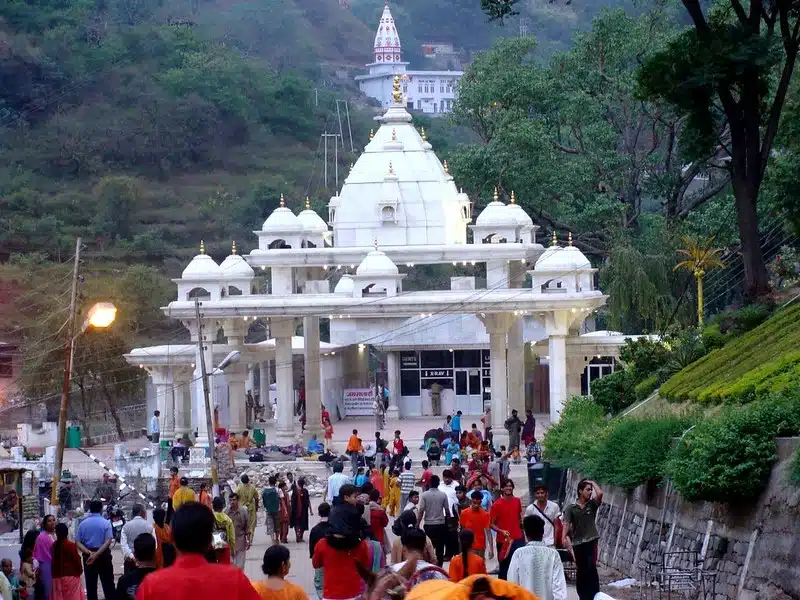Kolkata’s street food scene absolutely captured my heart. From the tangy Puchkas to the spicy Desi Chinese chowmein, the savory Jhalmuri, and the crispy Tele-bhaja, the flavours are simply out of this world. Don’t get me wrong, there’s a lot to love about Kolkata—its stunning architecture, rich literary culture, and much more. But for a foodie like me, it’s the unique culinary experiences that really stand out.
One sunny afternoon, I decided to dive deeper into this flavorful world. I booked a Savaari car rental in Kolkata, with the mission of exploring the city’s culinary hotspots. With my trusty driver Mounish at the wheel, we ventured through the bustling streets of Camac Street, tasting everything in sight.
Just when I thought my gastronomic journey was complete, Mounish threw in a surprise. He mentioned a place I’d never even heard of—a Chinese Kali temple where chop suey and momos are offered as prasad. I was intrigued and instantly said, “Hell yes!” How could I pass up the chance to visit a temple where some of my favourite dishes are part of the religious offering? And so, our adventure took a divine turn, leading us to one of Kolkata’s most unique cultural experiences.
Divine fusion – Exploring Kolkata’s unique Chinese Kali Temple
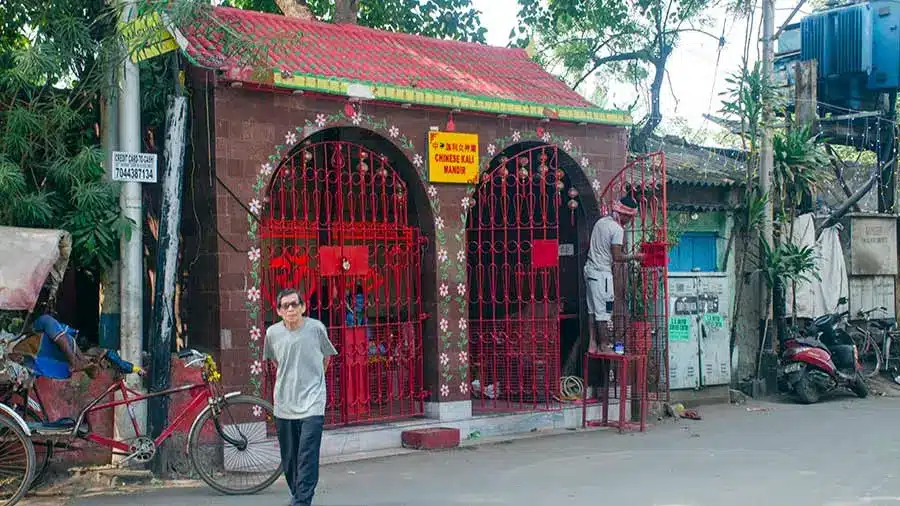
Navigating through the streets of Kolkata, a blend of chaos and charm, we made our way to Tangra. As we pulled up to the temple, I paused to take in the sight before me. The small, strikingly red structure—symbolic of good fortune and joy in Chinese culture—was adorned with ornate metal grills featuring detailed designs. The saffron drapes hanging at the entrance added a distinct Indian touch, typical of Hindu temples, creating a beautiful contrast against the red.
At first glance, it may look like just an ordinary roadside shrine surrounded by a tree. It houses several idols and framed photos of Hindu gods and goddesses but a closer inspection will show a few unusual diversions. The ceiling contains a painting of an eagle and dragon done in Chinese style. The backdrop of the idol contains a glow sign with Chinese motifs along with the om symbol. Also, outside the temple, between the arches is a bi-lingual (Chinese and English) board saying ‘Chinese Kali Temple’.
Stepping inside, I bumped into a local named Valerie Chang. Valerie, a Chinese Roman Catholic, was just passing by. She encouraged me to go in, sharing that she stops here for pooja every morning, even on Sundays before heading to morning mass at her church. It was then I realized that this unique temple welcomes worshippers from all religions, truly embodying the spirit of inclusivity.
A sacred melting pot – The origin of Chinese Kali Temple Kolkata
Full of questions, I turned to Valerie to delve deeper into the presence of the Chinese community in Tangra and their unique temple dedicated to Kali Mata. I was puzzled, given that the Chinese government officially recognizes only five religions—Buddhism, Catholicism, Islam, Protestantism, and Taoism—with no mention of Hinduism.
Valerie enlightened me on the intriguing history of this special place. During the 1930s civil war in China, a large group of people were evicted from the country, who took shelter in Tangra, Kolkata (then Calcutta) and took up work at tanneries. However, over the years, their profession shifted to the food industry, giving birth to what we call Indo-Chinese cuisine. Over time, the Chinese community gravitated towards the heart of Kolkata, creating the first Chinatown in the Territi Bazar area. Eventually, they relocated to Tangra, setting up tanneries and eateries, which led to the emergence of the city’s second Chinatown.
In Tangra, a pair of granite stones smeared with vermillion and placed under a tree became a local shrine. For six decades, Hindus revered these stones. The turning point came when a 10-year-old Chinese boy, gravely ill and beyond medical help, was laid in front of the stones. His desperate parents prayed fervently, and miraculously, he recovered completely. Overwhelmed with gratitude, the boy’s parents spearheaded a fundraising effort among the Chinese residents to build a proper temple for the revered stones. This temple, now cared for by the local Chinese community, has stood for 80 years as a testament to faith and unity across cultures.
Daily rituals at Kolkata’s Chinese Kali Temple in Tangra
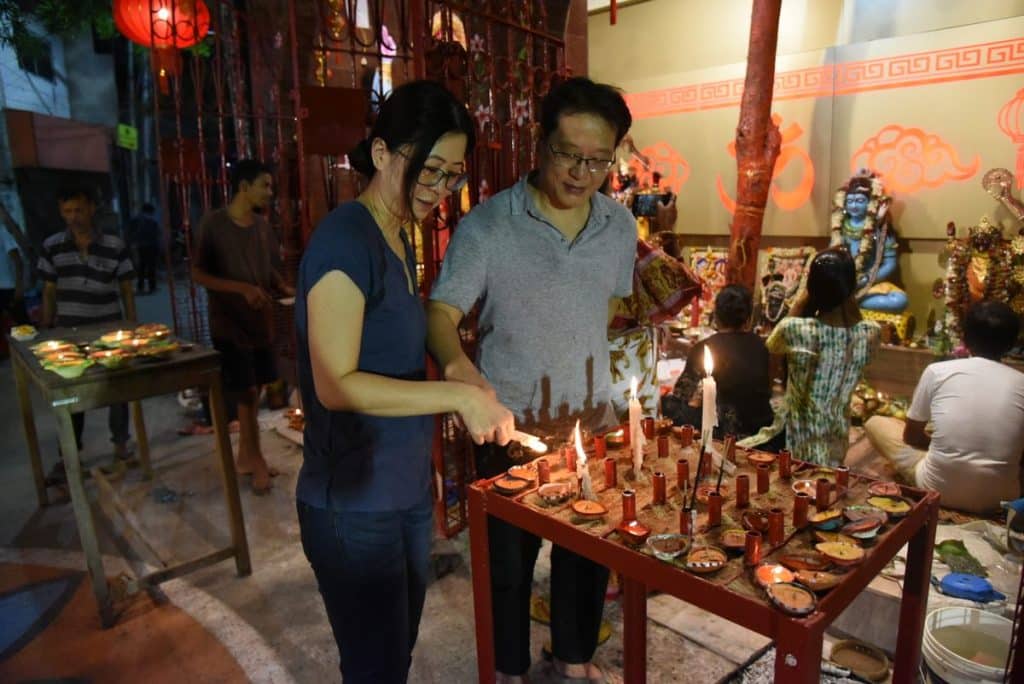
Waiting outside the temple, I witnessed a scene filled with cultural harmony. Around 6:45, a Bengali Hindu priest arrived and began to prepare the shrine, adorning the idol of Kali Mata with hibiscus flowers. Valerie, who was with me, explained that pujas are conducted daily at 9:30 AM and 7 PM, complete with the chanting of Sanskrit mantras.
As 7 PM approached, about eight members of the Chinese community entered the temple. They bowed deeply in prayer before the goddess, adding a serene atmosphere to the place. The aroma in the temple was unique; Chinese incense sticks filled the air, and handmade paper was burned in a traditional act of veneration, similar to practices in Chinese churches to ward off evil spirits during the evening aarti.
In a beautiful blend of cultures, the goddess was offered an assortment of dishes such as noodles, chopsuey, and rice-and-vegetable preparations such as bhog. I learned that the shrine is looked after by Sanjay Prasad (Pappu), who also owns a local Chinese restaurant. The entire experience was unlike anything I had ever seen, a true symbol of the mingling of diverse traditions and faiths.
Beyond Laddoos – A culinary twist at the Chinese Kali Temple
At the Chinese Kali Temple in Kolkata, the concept of prasad takes a fascinating twist that sets it apart from traditional offerings found in other temples across India. Typically, temples serve sweets like laddoos or halwas, or in the case of Bengal, an array of fruits, puffed rice, and mishti doi as prasad. However, this temple breaks away from the norm. As detailed in this blog, Kolkata’s street food scene is unmatched, and the temple reflects this culinary diversity in its prasad. Here, worshippers are treated to a variety of Chinese dishes. Noodles, chop suey, chow mein, fried rice, and vegetarian Manchurian are offered as sacred offerings to devotees.
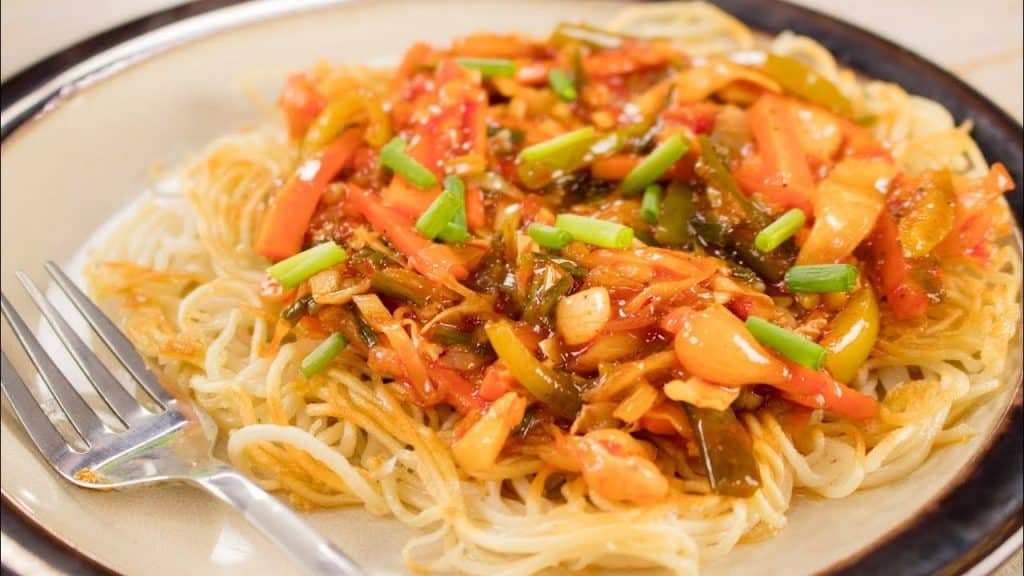
The puja at the temple adheres to strict Vedic rituals, despite the unconventional prasad. The temple houses a Narayan shila, a sacred stone representing Lord Narayan, which necessitates that all offerings be vegetarian. The bhog (food offered to the deity) is prepared and offered with great reverence, especially on selected days, typically following the new moon. This blending of Vedic religious practices with Chinese culinary traditions in the offering of prasad at the Chinese Kali Temple. This uniqueness is further exemplified by two awards and the trophies received by the temple, which are proudly displayed inside the temple.
Exploring Tangra – A guide to Kolkata’s mini Chinatown
Besides visiting the Chinese Kali temple, Tangra offers much more than just spiritual allure. Home to approximately 5,000 Chinese Indian nationals, this neighbourhood is a vibrant hub of Chinese traditions and cultural fusion. To fully experience all that Tangra has to offer, booking a cab in Kolkata is essential. Whether you’re a foodie, history buff, or cultural explorer, Tangra has something special for everyone. Here’s why Tangra is a must-visit:
Historic charm and architecture
Since the early 1900s, Tangra has been the heart of Kolkata’s Chinese community, especially after Hakka Chinese relocated here to run tanneries. Through the 1930s and 1940s, it became a refuge for many from South China. Despite a decline during the Sino-Indian War in the early 60s, today, around 5,000 Chinese residents continue to enrich this historic area with their traditions. Stroll through the streets lined with colourful, old buildings adorned with paper lanterns.
Authentic Chinese cuisine
Tangra is synonymous with authentic Chinese food. The area boasts a plethora of budget-friendly eateries serving everything from fried rice and pork soups to chilli prawns and dumplings. Popular spots like Beijing, Kim Fa, and Big Boss not only offer delicious dishes but also serve liquor. Don’t miss the quaint pastry shops sprinkled throughout the neighborhood.
The unmissable early morning Chinese breakfast
For an authentic start to your day, visit Tiretta Bazaar for a traditional Chinese breakfast. Be sure to arrive early, as vendors start serving delicacies such as momos, sausages, and pau buns from 6 AM and wrap up by 8:30 AM.
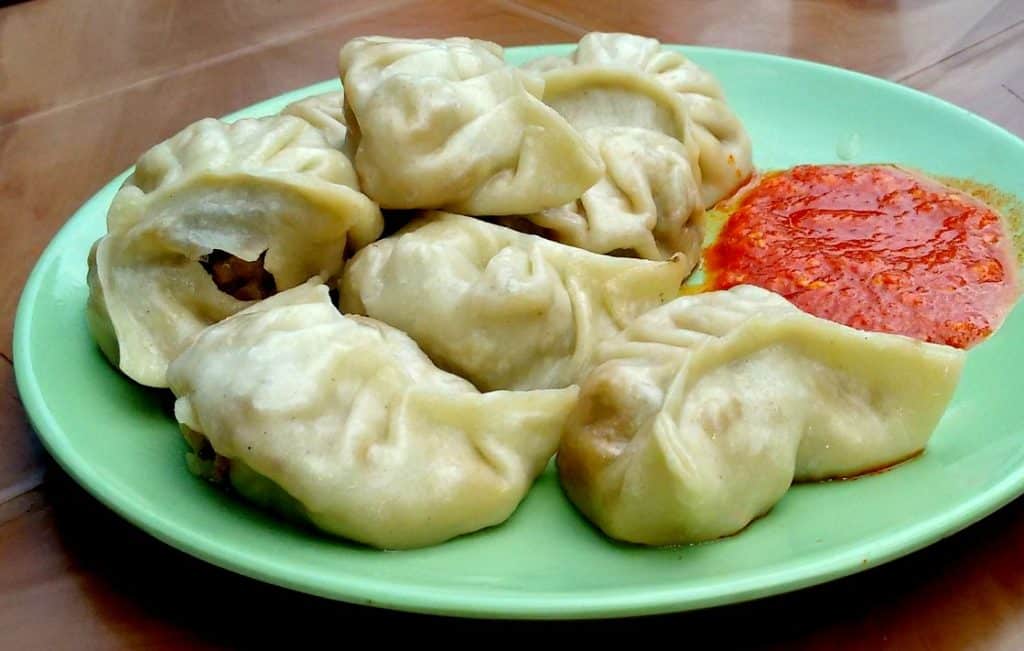
Unique shops and souvenirs
Tangra’s Chinatown Kolkata is dotted with shops selling a variety of intriguing items. Here, you can find everything from Chinese spices and medicines to showpieces ideal for souvenirs. Remember to haggle a bit to get the best deals.
Festive celebrations – The dragon dance
Experience the exuberance of the Chinese New Year celebrations in India in February. The neighborhood comes alive with lion and dragon dances, and cultural shows, complete with drums and cymbals to herald new beginnings. These festivities are a major draw in both Tangra and Tiretta Bazaar.
Diverse places of worship
Beyond the Chinese Kali Temple, Tangra is home to several Chinese churches where traditional religious practices are observed. Prominent sites include Sea Ip Church and Toong On Church, among others, each with its own unique history and community.
Once you’ve finished exploring Tangra, consider checking out this Kolkata travel guide to fully maximize your adventures. Kolkata has a wealth of attractions and activities that are sure to enrich your experience—you won’t be disappointed!
Best time to visit the Chinese Kali temple
When I inquired with the locals, they recommended that the best times to visit the Chinese Kali Temple are during Kali Puja and the Chinese New Year celebrations in February. Specifically, for an extraordinary experience, plan your visit on the evening of November 12th, around 10 PM, to observe a unique Kali Puja.
This event features two traditional dhakis (drummers) alongside the temple’s mechanized drums, creating a vibrant and unforgettable celebration. This cross-cultural festivity highlights the incredible diversity of Kolkata, often celebrated as a melting pot of cultures.
Why visit the Chinese Kali Temple with Savaari
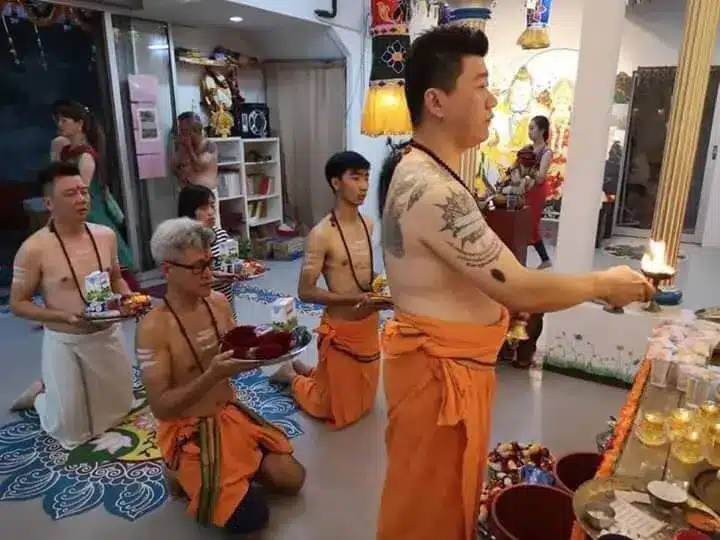
Visiting the Chinese Kali Mata Temple is not just a chance to see an intriguing place of worship but also an opportunity to dive deep into the rich variety of cultures that make India uniquely beautiful. This Kali temple in Kolkata is a perfect example of the country’s diversity and social harmony, showcasing an extraordinary blend of Chinese and Indian traditions.
While planning your visit, I strongly suggest taking some time to explore Tangra as well. There’s so much to discover in this vibrant neighbourhood. To make your trip as enjoyable and stress-free as possible, consider downloading the Savaari outstation cab booking app to book a chauffeur-driven cab. This was how I organized my visit, and it couldn’t have been more convenient. The comfort of having a knowledgeable local driver was unmatched. Plus, it was actually my driver who recommended visiting this unique temple in the first place! Thanks to his suggestion, I was able to make the most out of my journey, enriching my understanding and appreciation of Kolkata’s diverse cultural scene. So, go ahead and let yourself explore; you never know what amazing experiences await around each corner!
Last Updated on July 22, 2024 by blogadmin



